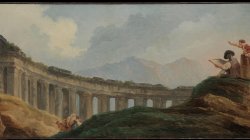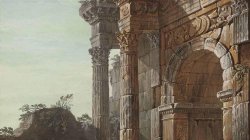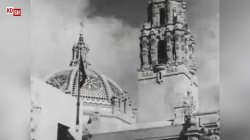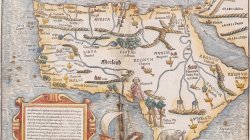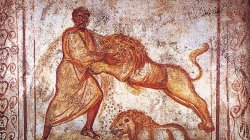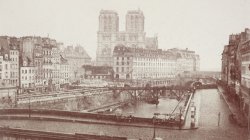You are using an out of date browser. It may not display this or other websites correctly.
You should upgrade or use an alternative browser.
You should upgrade or use an alternative browser.
Random Article
-
Replies: 8
Blog Information
-
Replies: 27
Question | The Mandela Effect...
-
Replies: 0
Patagonian Giants. What was their fate?
-
Replies: 2
Question | 1862 San Francisco Giants: what is he talking about?
-
Replies: 1
1896: Tower Crane with Operator Cabin
My first video. How did they pull it off?
- 11,363
- 12
- 25
Feels like a coming out of sorts, lol. Anyways, I spent some time making my first video. In the process dropped the ball, for I did not get my AI point across. So, there it is. That was a totally new experience for me. At some point, I will probably try to make a second one. Considering that there is a gadzillion of varios stolen history related videos already out there, offering something new and useful is a challenge. In case you have a...
Continue…
Ancient Canals of the South-West coast of Florida
- 11,368
- 7
- 15
It's always encouraging to see that even back in 1877, there were individual explorers who had no idea who was responsible for building certain things. In this case we are talking about several canals in the south-west Florida. Obviously, Florida has way more than just "several" canals unaccounted for. Yet, having witnesses dated with 1877 and 1885 calling these canals ancient, has to mean someting.
Continue…
Primary Sources, according to an A.I.
- 26,452
- 23
- 15
Hello everyone. It has been awhile, I have been busy with a move and just life in general, but I hope to start re-engaging with the site shortly. I have a few items that I need to follow up on and a few fresh investigations, but in the meantime, I just thought I’d share this conversation I had with ChatGPT. If you’re unfamiliar, it’s a neat resource that seems to be basically a wikibot combined with some knowledge of rhetoric and obfuscation…...
Continue…
American Chestnut Trees: Natural Extinction, or Victims of Bioweaponry?
- 39,405
- 29
- 19
The chestnut blight was accidentally introduced to North America around 1904 when Cryphonectria parasitica was introduced into the United States from East Asia from the introduction of the cultivation of Japanese chestnut trees into the United States for commercial purposes. It was first found in the chestnut trees on the grounds of the New York Zoological Garden (the "Bronx Zoo") by Herman W. Merkel, a forester at the zoo. In 1905, American...
Continue…
Helen of Troy, The Fountain of Light and the Eye of Ra Device
- 31,520
- 8
- 11
We are to believe that for 10 years, thousands of people (and many Gods) were involved in various combat related activities over a... woman. Could it be that the event we know as the Trojan War was fought over a piece of "pre-flood" ancient technology other than over a woman? As we know, history is written by victors. Losers are normally not allowed to contribute. What if the reasons for this (highly questionable by some) war were totally...
Continue…
Question | Year 2030: what are they hiding?
- 114,469
- 100
- 24
World civilization cycles are one of the topics that I've been pondering on for a while now. Industrial revolutions appear to be convenient enough for re-introducing older technologies into the newly developing, post-apocalypse spins of the world civilization. From this perspective, the infatuation of the elites (imho, some of them do know what's up) with "2030" could be rather interesting. Additionally, we are obviously dealing with certain...
Continue…
The Grand Canyon is under 450 years old...?
- 30,594
- 11
- 8
John Wesley Powell (1834 – 1902) was a U.S. soldier, geologist, explorer of the American West, professor at Illinois Wesleyan University, and director of major scientific and cultural institutions. He is famous for the 1869 Powell Geographic Expedition, a three-month river trip down the Green and Colorado rivers, including the first official U.S. government-sponsored passage through the Grand Canyon.
Continue…
Manoa El Dorado, Lake Parime, the Lost City of Gold and the Headless People
- 17,238
- 0
- 7
Lake Parime is a legendary lake located in South America. It was reputedly the location of the fabled city of El Dorado, also known as Manoa, much sought-after by European explorers. Repeated attempts to find the lake failed to confirm its existence, and it was dismissed as a myth along with the city. The search for Lake Parime led explorers to map the rivers and other features of southern Venezuela, northern Brazil, and southwestern Guyana...
Continue…
1891 Cable Road Construction in NYC
- 9,221
- 1
- 8
Built in 1891, the short-lived Broadway Cable Railroad ran north along Broadway, from Bowling Green at the southern end of Manhattan, uptown to 36th Street. This early form of mass transit operated by means of two giant cables (powered by centrally positioned steam engines), which ran just below street level, pulling the cable cars along the track at a steady 30 miles per hour. Unfortunately, the underground cables-and hence the trains...
Continue…
Area 51 a.k.a. Totonteac: the Seventh City of Cibola?
- 34,711
- 23
- 16
The United States Air Force facility commonly known as Area 51 is a highly classified remote detachment of Edwards Air Force Base, within the Nevada Test and Training Range. According to the CIA, the correct names for the facility are Homey Airport and Groom Lake, though the name Area 51 was used in a CIA document from the Vietnam War. The facility has also been referred to as Dreamland and Paradise Ranch, among other nicknames. USAF public...
Continue…
1888: Casa Monica Hotel by Franklin W. Smith
- 11,656
- 1
- 3
HistoricHotels.ORG tells us that in May 1887, Henry Flagler - railroad pioneer, hotel magnate and co-founder of Standard Oil - sold a parcel of land in St. Augustine, Florida to Bostonian amateur architect, Franklin W. Smith. On New Year’s Day 1888, Smith opened the historic Casa Monica Hotel. Four months later, Henry Flagler purchased Casa Monica and "all fixtures, furnishings, silver, hardware, linen, bedding, parlor, hall, dining room, and...
Continue…
Acropolis aka Necropolis, Schliemann and 1877 Cremation Temple
- 19,326
- 17
- 8
The Acropolis of Athens is an ancient citadel located on a rocky outcrop above the city of Athens and contains the remains of several ancient buildings of great architectural and historic significance, the most famous being the Parthenon. The word acropolis is from the Greek words ἄκρον (akron, "highest point, extremity") and πόλις (polis, "city"). Although the term acropolis is generic and there are many other acropoleis in Greece, the...
Continue…
Old Bergman Tools Building, Buffalo, NY
- 49,973
- 48
- 12
This building is located very close to my house. It's right along the Niagara River on Niagara Street, which is a very historic area in Buffalo. The destruction of the Buffalo "community" and Black Rock in the War of 1812 allegedly occurred all along this stretch. The YouTube channel Bushwhacking History in Buffalo has some detail on this stretch, though I'm not completely familiar with all his content. Not enough hours in the day...
Continue…
The Port of Marseille Ancient Tunnel or the Vieux-Port Tunnel?
- 21,320
- 8
- 7
The Vieux-Port Tunnel is located in downtown Marseille near the entrance to the city's former commercial port, now a marina. It connects the north and south shores of the port and in fact the north and south districts of the city. It is in fact made up of two tunnels - East and West - with two lanes each and reserved for light vehicles. Its length is 600 meters (1,968 feet). In the 1960s, Marseille was already experiencing endless traffic...
Continue…
Chronology: how old is Odessa and what's its name?
- 65,882
- 20
- 21
Odessa was the site of a large Greek settlement no later than the middle of the 6th century BC. A necropolis from the 5th–3rd centuries BC has long been known in this area. In the Middle Ages successive rulers of the Odessa region included various nomadic tribes, the Golden Horde, the Crimean Khanate, the Grand Duchy of Lithuania, and the Ottoman Empire. In 1794, the city of Odessa was founded by a decree of the Russian empress Catherine the...
Continue…
52 BC Battle of Alesia: where and when did it happen?
- 21,340
- 4
- 10
For Caesar, Alesia was an enormous personal success, both militarily and politically. The senate declared 20 days of thanksgiving for this victory but, due to political reasons, refused Caesar the honor of celebrating a triumphal parade, the peak of any general's career. Political tension increased, and two years later, in 49 BC, Caesar crossed the Rubicon, precipitating the Roman Civil War of 49–45 BC, which he won. After having been...
Continue…
Suvorov, Yermak, Pugachev, Razin and the Siberian War
- 23,413
- 10
- 13
Without historical individuals and without real chronology we have no history. Unfortunately, this is exactly what we have in my opinion - no history. Instead of the real history we have an intertwined web of fictitious story lines. Years of polishing turned these story lines into our current narrative. The end result is still the same, for no good fiction will ever make up for the true history. Winston Churchill allegedly said "A nation that...
Continue…
1845: The Great Fire of Pittsburgh
- 29,004
- 15
- 13
The fire destroyed 10-12,000 buildings, displacing 2000 families, or about 12,000 people. Property values skyrocketed, and a construction boom started on April 14, only 4 days after the fire. By June 12, while many streets were still blocked with fire debris, 500 new buildings were either completed or in progress. Fine buildings of brick or stone replaced the destroyed wooden tenements. Pittsburgh came back from the great fire bigger and...
Continue…
Napoleonic Wars and Year 1812: when did they happen?
- 30,320
- 10
- 14
A series of wars, known collectively as the Napoleonic Wars, extended French influence to much of Western Europe and into Poland. At its height in 1812, the French Empire had 130 departments, ruled over 44 million subjects, maintained an extensive military presence in Germany, Italy, Spain, and the Duchy of Warsaw, and counted Austria and Prussia as nominal allies. Early French victories exported many ideological features of the Revolution...
Continue…
Napoléon, aka Nicholas, Brutus and Ali Bonaparte: what do we know?
- 29,649
- 9
- 14
Napoléon Bonaparte was a French military and political leader who rose to prominence during the French Revolution and led several successful campaigns during the Revolutionary Wars. He dominated European and global affairs for more than a decade while leading France against a series of coalitions in the Napoleonic Wars. He won most of these wars and the vast majority of his battles, building a large empire that ruled over continental Europe...
Continue…
Latest resources
-
-
-
-
Queen Califia and the Island of California She Ruled in ParadiseUntil the Great Floods Of the Early 1800’s
-
Blog Statistics
- Articles
- 670
- Comments
- 4,045
- Media items
- 848
- Resources
- 104
- Views
- 8,739,514
- Members
- 1,523
- Latest member
- Oleksandr


